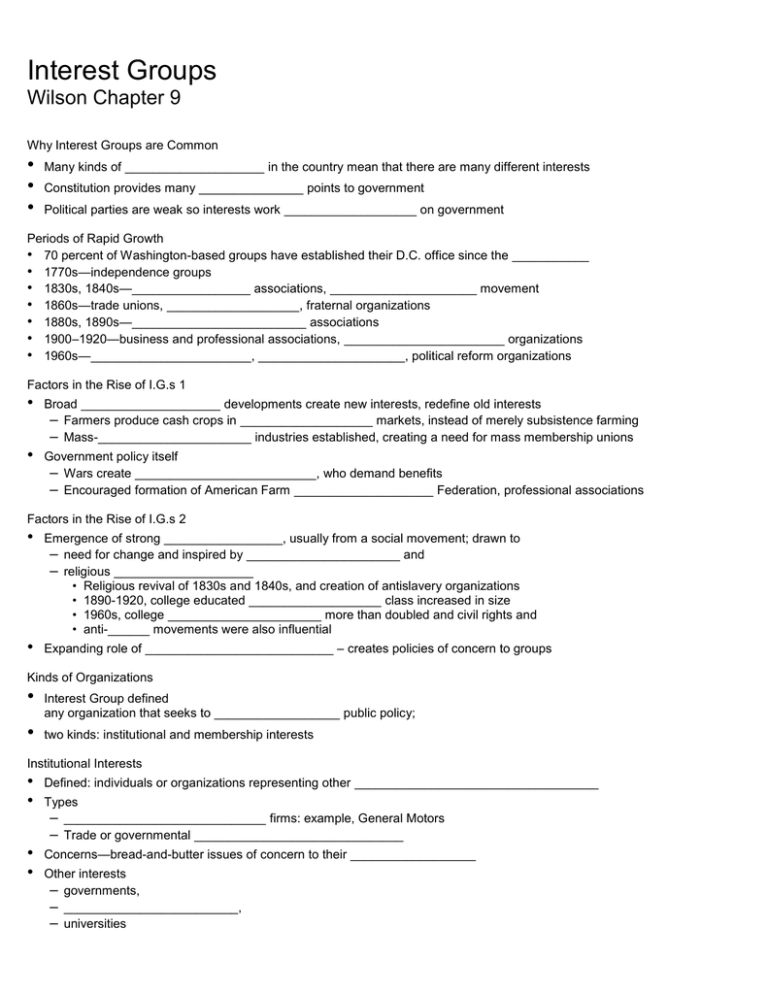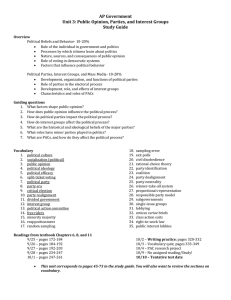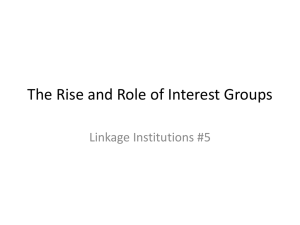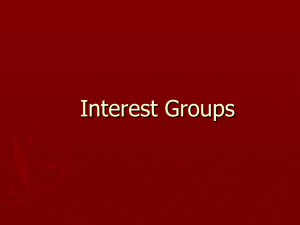Interest Groups Wilson Chapter 9 •
advertisement

Interest Groups Wilson Chapter 9 Why Interest Groups are Common • • • Many kinds of ____________________ in the country mean that there are many different interests Constitution provides many _______________ points to government Political parties are weak so interests work ___________________ on government Periods of Rapid Growth • 70 percent of Washington-based groups have established their D.C. office since the ___________ • 1770s—independence groups • 1830s, 1840s—_________________ associations, _____________________ movement • 1860s—trade unions, ___________________, fraternal organizations • 1880s, 1890s—_________________________ associations • 1900–1920—business and professional associations, _______________________ organizations • 1960s—_______________________, _____________________, political reform organizations Factors in the Rise of I.G.s 1 • • Broad ____________________ developments create new interests, redefine old interests – Farmers produce cash crops in ___________________ markets, instead of merely subsistence farming – Mass-______________________ industries established, creating a need for mass membership unions Government policy itself – Wars create __________________________, who demand benefits – Encouraged formation of American Farm ____________________ Federation, professional associations Factors in the Rise of I.G.s 2 • • Emergence of strong _________________, usually from a social movement; drawn to – need for change and inspired by ______________________ and – religious ____________________ • Religious revival of 1830s and 1840s, and creation of antislavery organizations • 1890-1920, college educated ___________________ class increased in size • 1960s, college ______________________ more than doubled and civil rights and • anti-______ movements were also influential Expanding role of ___________________________ – creates policies of concern to groups Kinds of Organizations • • Interest Group defined any organization that seeks to __________________ public policy; two kinds: institutional and membership interests Institutional Interests • • • • Defined: individuals or organizations representing other ___________________________________ Types – _____________________________ firms: example, General Motors – Trade or governmental ______________________________ Concerns—bread-and-butter issues of concern to their __________________ Other interests – governments, – _________________________, – universities Membership Interests • _____________________________ join some groups more frequently than citizens in other nations – Social, business, _______________________________, veterans’, charitable—same rate as elsewhere – ____________________—less likely to join – Religious, political, civic groups—__________ likely to join – Greater sense of political _________________, civic duty seems to explain tendency to join civil groups Incentives to Join 1 • • _____________________ incentives—pleasure, companionship – require organizations to structure themselves as __________________________ of small local units – Facilitated by the importance of _____________ governments in the U.S. – Examples: League of Women Voters (LWV), _____________, Rotary, Parent-Teacher Association, American Legion _____________________ incentives—money, things, services (farm organizations, AARP) Incentives to Join 2 • ________________________ incentives—goal/purpose of the organization itself – Though this group also benefits nonmembers, people join because: • They are passionate about the _________(s) of the organization • They have a strong sense of civic _________ • Cost of joining is minimal – ___________________________ interest groups—appeal of coherent and, often, controversial principles Incentives to Join 3 • Purposive incentives (cont’d) – Public interest groups—purpose principally benefits nonmembers (example, _____________ groups) – Engage in research and bring ___________________, with liberal or conservative orientation – Publicity important because purposive groups are influenced by mood of the times – they may prosper when the government is ____________________ to their agenda Influences of Staff on Practices • • Staff influences the group’s policy ___________________ if solidarity or material benefits are more important to members (than are purposive goals) National Council of ____________________ of Christ and unions are examples Social Movements = Purposive Incentives 1 • • Social movement: a widely _________________ demand for change in the social or political order, either liberal or conservative The _______________________________ movement demonstrates that . . . – Movement may spawn many _____________________________ – More extreme organizations will be ___________________ and more activist – More moderate organizations will be larger and less activist Social Movements = Purposive Incentives 2 • The __________________________ movement; three kinds of organizations – Solidary • Middle class __________________________ women • LWV, Business and Professional Women’s Federation • Avoid issues that might _______________________ members ship or limit networks (examples: partisanship, abortion) Social Movements = Purposive Incentives 3 • Feminists (cont’d) – Purposive – • Strong positions are taken on divisive issues, highly _______________________ organizations • Internal _______________________________ is common • Local organizations are highly independent from national organization • Examples: __________, ________________ Material • Addresses _____________________ issues of material benefit • Examples: National Women’s Political Caucus (NWPC), National Federation of Republican Women Social Movements = Purposive Incentives 4 • Unions continue the activism after their _______________ movement died, but sustaining membership is difficult – Economic __________________________ have not worked to unions’ benefit in member recruitment – Public _______________________ of unions has declined – But unions do offer a mix of _______________ and are attracting white collar employees (example: government workers) Funds for Interest groups beyond member dues • Foundation __________________ • Federal grants and ______________________ • Direct _________ – Unique to modern interest groups – Through the use of _________________________, mail is sent directly to a specialized audience – But this approach is also expensive – must generate checks from at least ___ percent of the people contacted – Techniques • _____________________ on the envelope • Letter arouses emotions • ________________________-name endorsement • Personalization the letter Problem of Bias • Reasons for belief in upper-class ________________ – More ______________________ more likely to join and be active – Business/____________________________ groups more numerous and better financed than those representing minorities, consumers, or the disadvantaged • These facts do not decide the issue because . . . – Describe inputs to the political system but not who eventually ___________ or _______________ on particular issues – Business groups are often divided among themselves • Important to ask what the bias is – Many conflicts are among upper-middle class, politically active ________________ – _______________________ differentials are clues, not conclusions about the outcomes of political conflicts Activities of Interest Groups (overview) • • • • • Supplying credible ____________________________ Public ______________________: the rise of the new politics __________________ and PACs The “_______________________ door” Trouble Supplying Credible Information • Single most important ______________________ • Detailed, current information at a premium and can build (or destroy) a ______________________ – lobbyist relationship • Most effective on narrow, _______________________ issues— links to client politics • Officials also need political cues regarding what ____________________ are at stake and how that fits with their own political beliefs – so groups may establish informal _________________________ based on their general political ideology • Rating systems are intended to generate support or opposition for legislators Public Support: Rise of New Politics • ________________ strategy previously most common—face-to-face contact between lobbyist and member or Hill staff • Increasing use of ____________________ strategy—grassroots mobilization of the issue public (effects of individualistic Congress, modern technology) • Politicians dislike ____________________________, so work with interest group they agree with • Lobbyists’ key targets: the _______________________ legislator or bureaucrat • Some groups attack their likely ________________ to embarrass them • Legislators sometimes buck public _____________________, unless the issue is very important and would cost them an election • Some groups try for grassroots support Money and PACs 1 • Money is the ________________ effective way to influence politicians • Campaign finance reform law of 1973 had two effects – _____________________________ amount interests can give to candidates – Made it legal for corporations and unions to create PACs that could make donations • Rapid growth in PACs has probably not led to vote buying – More money is available on all _______________ of the issues – Members of Congress take money but still can decide how to ____________ – _____________________ are establishing their own PACs, to advance their political ambitions Money and PACs 2 • • • Almost any ____________________________ can create a PAC – Over half of the PACs are sponsored by _________________________, one-tenth by unions, and remainder vary – Recent increase in ideological PACs: one-third ____________________, two-thirds conservative Ideological PACs raise more money, but raising the money also __________________________ those resources In 1998, ________________ and business/professional organizations gave the most Money and PACs 3 • __________________________ get the most PAC money • PACs provide only one-____________ of the money spent by House candidates – Labor PACs almost exclusively give to ___________________________ – Business PACs _________________ money between Democrats and Republicans – Democrats often receive more ___________ money than do Republicans Money and PACs 4 • No systematic evidence that PAC money ______________________________ votes in Congress – Most members vote their __________________________ and with their _____________________________ – When an issue is of little concern to voters and ideology provides little guidance, there is a _________________ correlation between PAC contributions and votes, but that may be misleading – PAC money may influence __________________________ in other ways, like access or committee actions – PAC money most likely to influence client politics, see Chapter 15 Revolving Door • • • Very Important for AP Test! Promise of future _____________ to officials – does this lead to corruption? See How Things Work box, Conflict of Interest Trouble • • __________________________ has always been part of United States politics, and has been used by groups of varying ideologies, etc. Tactics have been more frequently used since the 1960s, becoming more generally accepted • • Goals: – Disrupt the institution and force _____________________________ – Enlist the ________________________ of others, who will also press for negotiations – Create ___________________________ to draw public concern and support Often create no-win situations for public officials, who are criticized whether they negotiate or not Regulating Interest Groups 1 • Protection by __________________ Amendment – 1946 Federal Regulation of Lobbying Act accomplished little in requiring registration and financial reports • ________________________ Court restricted application to direct contact with members of Congress • ___________________________ activity not restricted • No staff to enforce law by reviewing registration or reports Regulating Interest Groups 2 – 1995 act provided a broader ___________________________ of lobbying and tightened reporting requirements • • • • Requires reports twice a year, including client __________________, expenditures, issues Still exempted grassroots mobilization No enforcement agency established, but ______________________ Department may undertake investigations Tax-_____________________, nonprofit organizations cannot receive federal grants if they lobby Regulating Interest Groups 3 • Other significant _________________________ – Tax code; nonprofits lose tax-___________________ status if a “substantial part” of its activities involve lobbying – Campaign-finance laws limit donations by individual ____________ The End!



